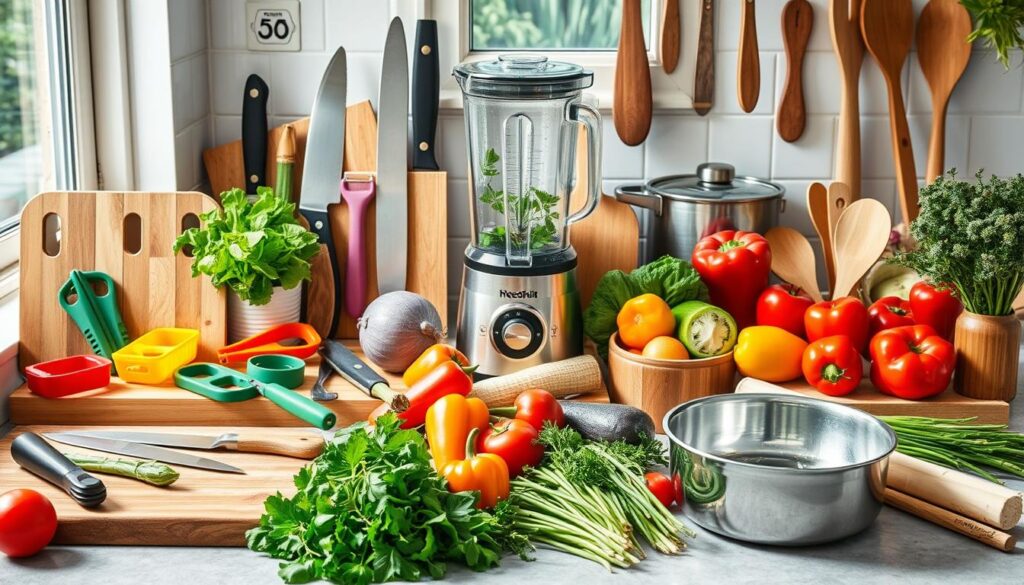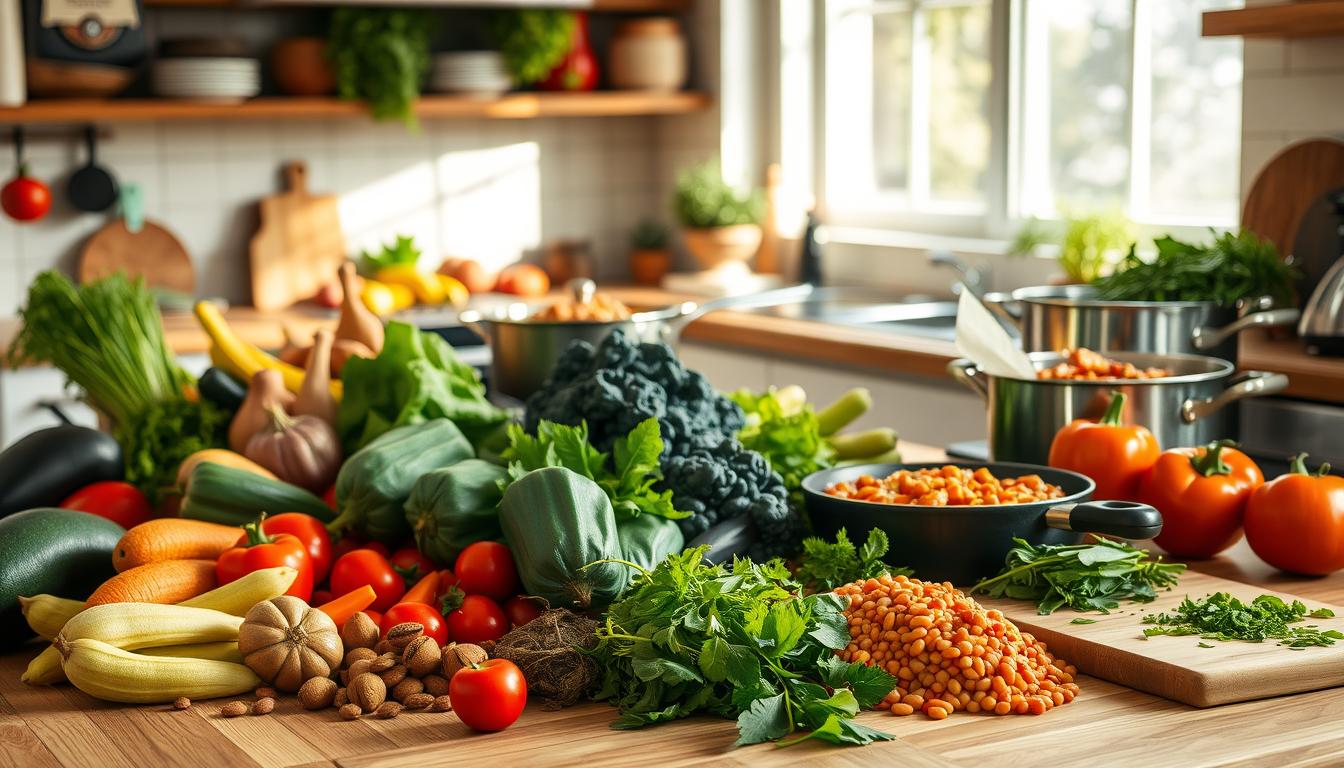What is vegan in cooking? A staggering 23% of Americans reported cutting back on meat consumption in 2020, a trend that has only continued to grow. As the popularity of plant-based diets surges, vegan cooking has become an increasingly mainstream culinary practice. But what exactly does it mean to cook vegan?
Vegan cooking involves the preparation of meals and dishes that are entirely plant-based, using no animal products whatsoever, including meat, fish, eggs, dairy, and honey. It is a type of plant-based diet that aims to avoid the exploitation of animals as much as possible. Vegan cooking emphasizes the use of vegetables, fruits, nuts, legumes, whole grains, and plant-based proteins to create delicious, nutritious, and cruelty-free meals. This approach to cooking has become increasingly popular as more people seek to reduce their consumption of animal products for health, environmental, or ethical reasons.

Key Takeaways
- Vegan cooking is a plant-based approach that excludes all animal products, including meat, fish, eggs, dairy, and honey.
- It emphasizes the use of vegetables, fruits, nuts, legumes, whole grains, and plant-based proteins to create delicious and nutritious meals.
- The growing popularity of vegan cooking is driven by health, environmental, and ethical concerns about the consumption of animal products.
- Vegan cooking offers a wide range of meat alternatives and vegan baking options.
- Vegan cooking can be an excellent way to incorporate more plant-based proteins and cruelty-free ingredients into your diet.
Understanding Vegan Cooking
Defining Vegan and Plant-Based Diets
Vegan cooking is a subset of plant-based diets, which prioritize the use of plant-based ingredients. Veganism is a lifestyle that avoids the use of animal products in all aspects of life, not just in diet. In contrast, vegetarianism allows the consumption of some animal products like dairy and eggs. Plant-based diets can range from entirely vegan to more flexible approaches that include limited amounts of animal products. Vegan cooking focuses on creating delicious meals using only plant-based ingredients, without any meat, dairy, or other animal-derived components.
Vegan cooking can save piles of money as home-cooked dishes cost a small fraction of what restaurant meals or frozen foods would cost. Fresh and tasty meals can be made with high-quality ingredients while cooking vegan, leading to an enjoyable culinary experience. Various popular vegetables for vegan cooking such as broccoli, Brussels sprouts, cauliflower, and cabbage are part of the cruciferous family and may reduce cancer risk.
Leafy greens are nutrient-dense foods that can be stir-fried to condense their volume for easier consumption and improved digestibility. Onions come in different colors such as red, yellow, and white, and are commonly used in Mexican, Indian, and Italian cooking; Vidalia onions, with their sweet flavor, can be eaten raw or cooked.
Winter squash remains fresh until spring and is considered the most imperishable vegetable, with kabocha squash being noted for its exceptional flavor. Tomatoes should ideally be locally grown and vine-ripened for the best flavor and texture.
Pantry staples for vegan cooking include nuts, beans, rice, flour, dried fruit, breakfast cereals, and granolas, commonly available in bulk at natural food stores. Herbs, spices, and seasonings play a crucial role in vegan cooking, with various herbs like oregano, marjoram, and spices like cumin and coriander seeds being essential for flavor enhancement. Buying spices in bulk can save at least 50% compared to prepackaged options, allowing for cost-effective flavor enhancement.
Common Vegan Ingredients
Vegan cooking relies on a diverse array of plant-based ingredients to provide the necessary nutrients and flavors. These common vegan staples include a range of protein sources, meat alternatives, dairy substitutes, and whole food plant-based ingredients that form the foundation of delicious and nutritious vegan meals.
Vegan Protein Sources
Vegans have access to a wealth of protein-rich options, including tofu, tempeh, seitan, legumes, nuts, and seeds. Tofu and tempeh, derived from soybeans, offer versatile textures and can be prepared in numerous ways. Seitan, a vital wheat gluten product, provides a meaty and satisfying texture that appeals to many vegans. Legumes such as beans, lentils, and chickpeas are abundant in protein and can be used in a variety of dishes. Nuts and seeds, like almonds, walnuts, and chia seeds, are excellent sources of plant-based protein and healthy fats.
Plant-Based Meat Alternatives
For those seeking to recreate the taste and texture of meat, a range of plant-based meat alternatives are available. Ingredients like jackfruit, mushrooms, and soy-based burgers can be used to create convincing meat substitutes. These alternatives provide a satisfying experience for vegans and those transitioning to a more plant-based diet.
Vegan Dairy Substitutes
Dairy products can be easily replaced with a variety of vegan alternatives. Plant-based milks, such as soy, almond, rice, coconut, hemp, cashew, and pea milk, offer a wide range of options to cater to different dietary needs and preferences. Vegan cheeses made from ingredients like cashews or coconut can provide the creamy textures and flavors that are often associated with dairy products.
Whole Food Plant-Based Ingredients
At the core of vegan cooking are whole food plant-based ingredients, including an abundance of vegetables, fruits, whole grains, and healthy fats. Grains like rice, barley, oats, quinoa, and millet serve as nutritious and versatile staples. Vegetables, fruits, nuts, and seeds provide essential vitamins, minerals, and fiber, while ingredients like avocado, olive oil, and coconut oil offer heart-healthy fats.
By incorporating these common vegan ingredients into their culinary creations, home cooks can explore a world of delicious and nourishing plant-based meals.

Essential Kitchen Tools and Techniques
Vegan cooking often requires specialized kitchen tools and techniques to bring out the best in plant-based ingredients. From slicing and dicing to blending and mixing, having the right tools can make all the difference in creating delicious and visually appealing vegan meals.
Techniques for Vegan Cooking
Common vegan cooking techniques include steaming, boiling, stir-frying, and roasting, which help preserve the flavor and nutrients of plant-based ingredients. Techniques like blanching, sweating, and using plant-based binding agents are also essential for vegan cooking. Mastering these techniques can help vegan cooks prepare nutritious and satisfying plant-based dishes.
For slicing and dicing, a quality chef’s knife (around 8 inches) and a set of measuring cups and spoons are must-haves. A vegetable peeler and a julienne peeler can also be incredibly useful for creating intricate veggie-based dishes.
When it comes to cookware, a cast-iron skillet is a great investment for vegan cooking, as it provides a natural non-stick surface and excellent heat retention. A high-quality blender or food processor is also essential for making vegan sauces, dips, and even homemade plant-based cheeses.
Other useful vegan kitchen tools include a vegetable spiralizer for creating noodle-like dishes, a tofu press for removing excess moisture, and a citrus juicer for adding fresh, tangy flavors to vegan recipes.
| Essential Vegan Kitchen Tools | Benefits |
|---|---|
| Chef’s Knife (8-inch) | Precise cutting and slicing of vegetables and fruits |
| Measuring Cups and Spoons | Accurate measurement of ingredients for successful vegan baking and cooking |
| Cast-Iron Skillet | Excellent heat retention and natural non-stick surface for various cooking tasks |
| High-Speed Blender | Smooth and creamy vegan sauces, dips, and smoothies |
| Food Processor | Versatile for making vegan cheeses, veggie burgers, and more |

With the right vegan cooking tools and techniques, you can unlock a world of delicious and nutritious plant-based meals. Investing in quality kitchen essentials can make vegan cooking a more enjoyable and efficient experience.
Grocery Shopping for Vegan Ingredients
Successful vegan cooking starts with a well-stocked pantry and fridge. When vegan grocery shopping, focus on buying a variety of fresh produce, including leafy greens, vegetables, fruits, and herbs. Stock up on pantry staples like beans, lentils, whole grains, nuts, and seeds. Seek out plant-based milk alternatives, vegan condiments, and meat substitutes.
Many natural food stores and specialty markets have dedicated vegan sections to make grocery shopping easier. Carefully reading labels to identify vegan-friendly products is also important. With the right vegan ingredients on hand, you’ll be able to create delicious, nutritious plant-based meals at home.
Major grocery stores like Whole Foods, Trader Joe’s, Safeway/Vons, Wegmans, and Kroger carry a wide selection of vegan products. Farmer’s markets are also a great place to find fresh, seasonal produce and specialty vegan items. By stocking up on a variety of plant-based grocery list items, you’ll have the vegan pantry staples needed to whip up countless meatless meals.
FAQ
What is vegan in cooking?
Vegan cooking involves the preparation of meals and dishes that are entirely plant-based, using no animal products whatsoever, including meat, fish, eggs, dairy, and honey. It is a type of plant-based diet that aims to avoid the exploitation of animals as much as possible.
How is vegan cooking different from other plant-based diets?
Vegan cooking is a subset of plant-based diets, which prioritize the use of plant-based ingredients. Veganism is a lifestyle that avoids the use of animal products in all aspects of life, not just in diet. In contrast, vegetarianism allows the consumption of some animal products like dairy and eggs. Plant-based diets can range from entirely vegan to more flexible approaches that include limited amounts of animal products.
What are the common ingredients used in vegan cooking?
Vegan cooking relies on a variety of plant-based ingredients to provide the necessary nutrients and flavors. Common protein sources include tofu, tempeh, seitan, legumes, nuts, and seeds. Meat alternatives like jackfruit, mushrooms, and plant-based burgers can be used to recreate the texture and flavor of meat. For dairy substitutes, vegans can use plant-based milks, vegan cheeses, and ingredients like cashews or coconut to create creamy textures.
What are the essential kitchen tools and techniques for vegan cooking?
Vegan cooking may require some specialized kitchen tools and techniques. Essential tools include spiralizers for making vegetable noodles, slicers and mandolins for precise cutting, and blenders or food processors for creating vegan sauces and dips. Common cooking techniques in vegan kitchens include steaming, boiling, stir-frying, and roasting to preserve the flavors and nutrients of plant-based ingredients.
How can I stock my pantry and fridge for successful vegan cooking?
Successful vegan cooking starts with a well-stocked pantry and fridge. When grocery shopping for vegan ingredients, focus on buying a variety of fresh produce, including leafy greens, vegetables, fruits, and herbs. Stock up on pantry staples like beans, lentils, whole grains, nuts, and seeds. Seek out plant-based milk alternatives, vegan condiments, and meat substitutes. Many natural food stores and specialty markets have dedicated vegan sections to make grocery shopping easier.

